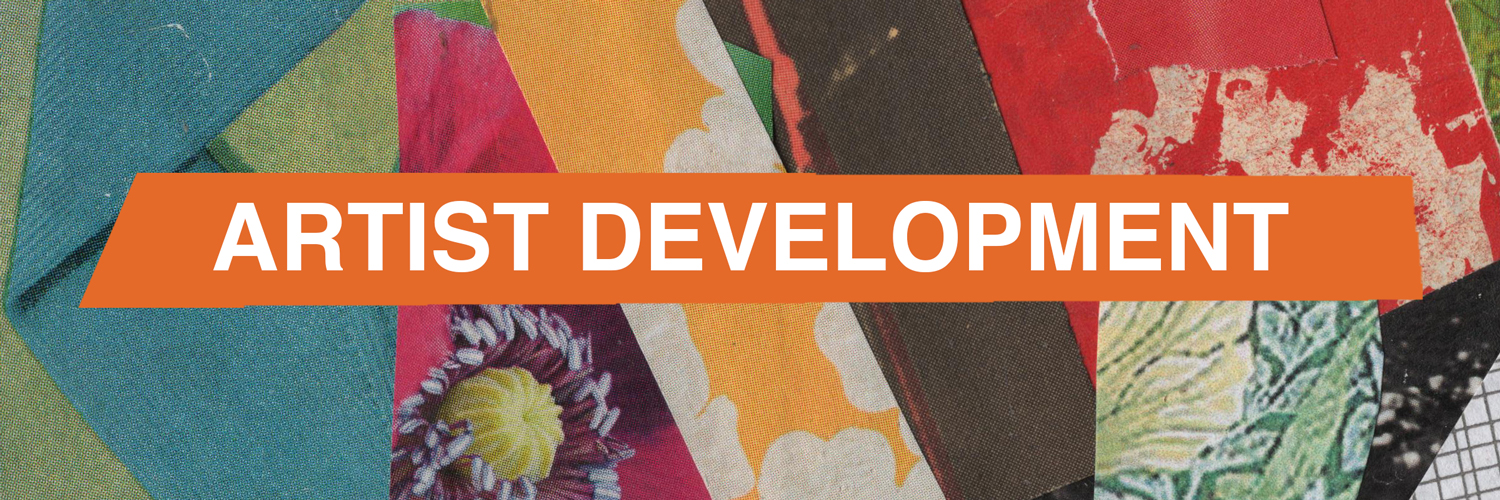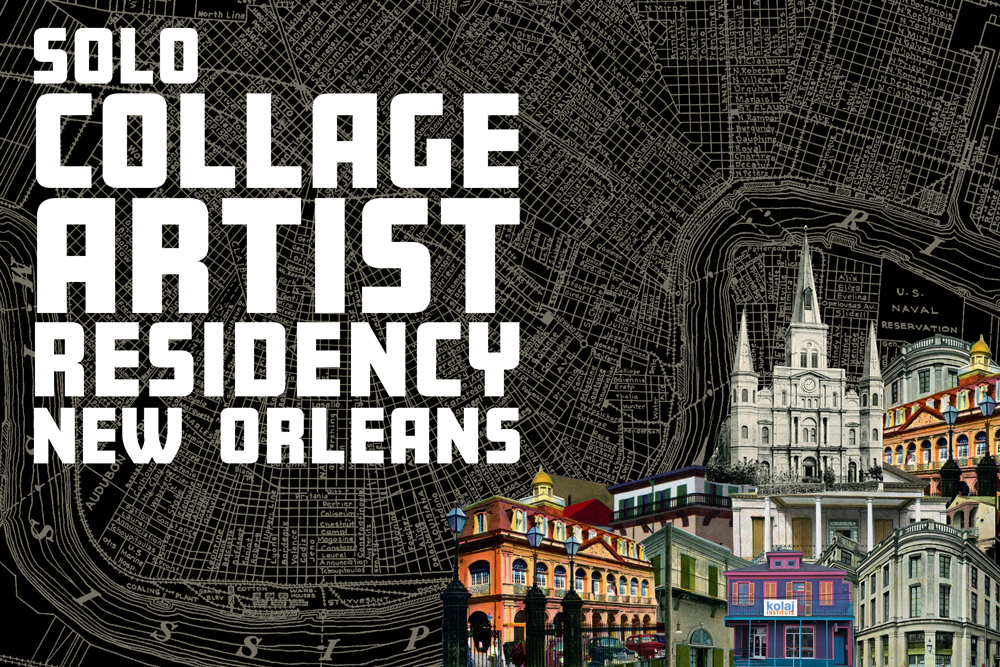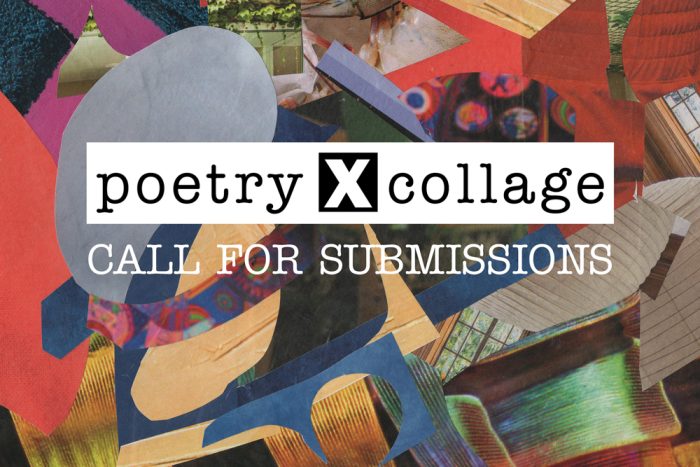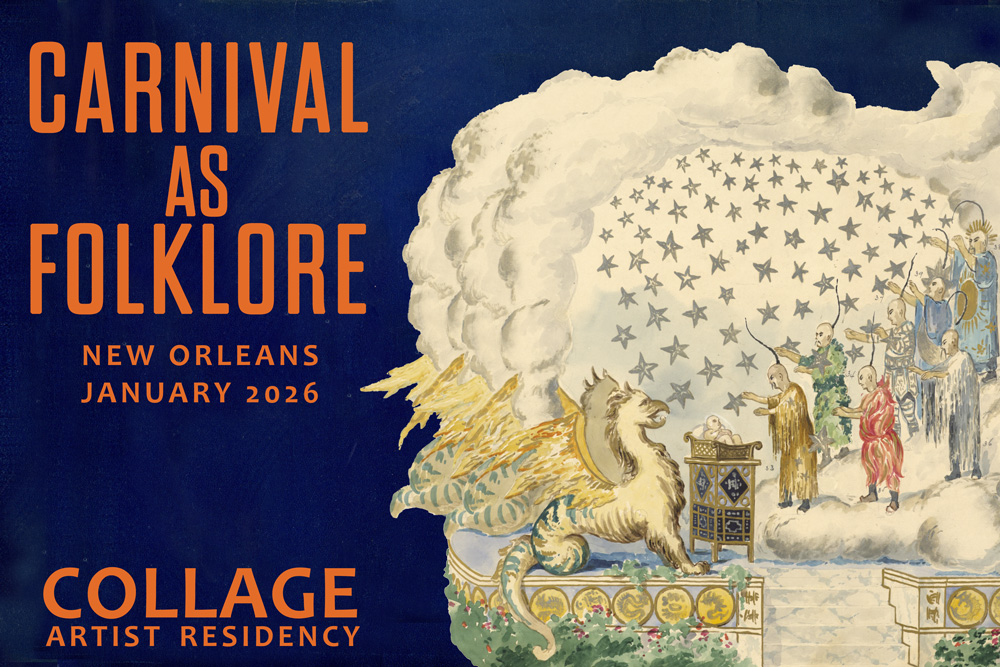
Kolaj Institute's Artist Development Program is a collection of three core workshops for self-motivated artists, at any stage in their career, who want to develop and expand their collage-based artist practice and work towards professional goals, particularly in the areas of exhibitions and publishing.
At Kolaj Institute, our philosophy is that if we bring artists together, explore ideas and concepts, share knowledge, we can stretch and develop as artists. When we bring that knowledge and skill into our communities, we raise the standing of collage and contribute to the civic discourse. To that end, we offer three core artist development workshops that are designed to support artists gain a deeper understanding of their art practice and to develop their practice so that they can achieve their professional and artistic goals.
Note: You do not have to commit to all three workshops. Use this form if you are interested in Collage in Practice, Curating Collage, and/or Collage Publishing.
Read the full program details here: https://kolajinstitute.org/artist-development/

Kolaj Institute Solo Residencies
Dates: One or Two-Week Residencies with dates mutually agreed with Kolaj Institute
DEADLINE: Wednesday, 31 December 2025 for dates in 2026
The mission of Kolaj Institute is to support artists, curators, and writers who seek to study, document, and disseminate ideas that deepen our understanding of collage as a medium, a genre, a community, and a 21st century movement. We operate a number of initiatives meant to bring together community, investigate critical issues, and raise collage’s standing in the art world.
Kolaj Institute’s solo residencies in New Orleans are designed to provide artists, curators, and writers with dedicated time and space to work on a project.
Projects may include things like:
- Completing a series of collage artworks
- Using the archive and collections to researching collage
- Exploring and making art about New Orleans as a place
- Working on a book project
- Creating a collection of collage poetry
- Making a stop motion collage film
- Preparing art for an exhibition
- Developing one’s practice to work on a larger scale
- Or taking a moment to review, organize, and document one’s art practice.
We are open to your ideas. We are looking for artists with an articulated goal for their time in New Orleans. That goal need not to be explicitly related to New Orleans, though priority will be given to those artists whose projects need time in New Orleans.
ABOUT THE RESIDENCY
Residencies may be 1 or 2 weeks. Kolaj Institute provides housing and studio space. Once accepted, Kolaj Institute meets with the resident for a pre-residency assessment where we identify community partners and other resources that can support the project. We then work with the resident to design a plan for their time in New Orleans.
Residents stay in Kolaj Institute’s space at the corner of Saint Claude and Saint Roch Avenues, where they will have their own bedroom, and a shared kitchen and bathroom with shower. (Alternative off-site housing is also available.) Residents work in Kolaj Institute’s Gallery that includes access to collage making supplies and a printer. The Gallery and Resident space is located on the second floor of a building in the Marigny neighborhood. The wrap-around balcony overlooks St. Roch Market. Residents work independently to complete their plan. At the end of the residency, we meet with the artist to review their progress with them and discuss next steps.
COST
The cost of the residency is $900 US for one week (including 6 nights accommodation) or $1400 US for two weeks (including 13 nights accommodation). If the artist is traveling with a partner or companion, there is an additional fee of $400 US per week. A limited number of grants are available in order to offset the fee and reduce barriers to participation to those with a demonstrated financial need. We cannot offer financial aid to cover travel, lodging or food costs.
All travel to and from New Orleans, as well as food and lodging, are the sole responsibility of the artist.
READ THE FULL CALL TO ARTISTS

PoetryXCollage Open Submission
PoetryXCollage is a printed journal of artwork and writing that operates at the intersection of poetry and collage. We are interested in found poetry, blackout poetry, collage poems, haikus, centos, response collages, response poems, word scrambles, concrete poetry, scatter collage poems, and other poems and artwork that inhabit this world.
Each issue presents six movements of work by artists and curators. Page spreads are meant to be free zones of thinking where the contributor has chosen all elements of the layout: font, image place, composition, etc.
Artists and writers interested in submitting should prepare 3-5 page spreads for consideration. Page spreads must conform to exact specifications and include a general artist narrative and a short page spread narrative. We strongly suggest reviewing a copy of PoetryXCollage prior to submitting. We also recommend downloading the PoetryXCollage Specs Doc pdf and reviewing its contents. You can download this Transparent PNG Template to make sure your submission is the correct size and accounts for the bleed and gutter.
Learn more about the PoetryXCollage project on Kolaj Institute's website HERE.
Questions? Send an email.
Kolaj Magazine‘s Artist Directory is a tool for organizing and cataloguing artists who work in the medium of collage. Its audience includes the general public as well as independent curators, art venues, and writers.
What Is the Kolaj Magazine Artist Directory?
Kolaj Magazine Artist Directory is a membership-based directory and advertising program. The editorial staff of Kolaj Magazine uses the Artist Directory to select artists to feature in the publication and to select artists for various curatorial projects and the Artist Directory exists as a public resource for those interested in collage as a medium and is designed to put interested parties in direct contact with artists. Members of the Artist Directory are permitted and encouraged to refer to their Listing when responding to Calls to Artists as a way of facilitating their response. The Kolaj Magazine Artist Directory is the primary online gateway of the Kolaj Institute Artist Archive and is used to organize online information about artist members. We offer members an option for an Artist Advertisement in the printed magazine.
Sign-Up Options
OPTION 1: ONLINE ONLY
The cost of a 12-month membership to the online Kolaj Magazine Artist Directory is $30.00.
OPTION 2: ONLINE & PRINT EDITION
The print edition of Kolaj Magazine features a directory of collage artists. (see example here) Listings are paid advertisements that feature an image as well as the name; city, state, & country; and website or email of the artist. The listings appear in a box that is 3.7 inches wide and 3 inches tall. After you select and send the images to be featured, Kolaj staff will prepare the listing and send you a digital proof if requested. The cost is $60 per issue (or four issues for $160) and includes a 12-month membership to the online directory.
Sign-Up Process
The registration process will ask you for:
Artist Bio
Artist Statement
3-5 images & captions
Collage Books is Kolaj Magazine’s tool for organizing, documenting, and cataloguing books in which collage plays an important role. Our audience includes readers and collectors of collage books as well as curators, art venues, and writers.
We seek submissions of collage-related titles. We take a broad view of collage books and include trade editions, art criticism, coffee table books, ‘zines, artist books, catalogues, literary endeavours that feature collage.
We accept submissions from traditional publishers, small presses, and individual artists and writers.
Inclusion in the directory is at the discretion of the publisher. If you are interested in advertising in the “Collage Books” section of the print magazine, send us an email for details.
Take a look at some of the Directory pages before submitting so you can see how they are laid out and what information is needed for submission.
Sign-Up Process
The registration process will ask you for:
Title and author information
Publisher information
Book Details
An announcement or press release
3-5 images & captions
Review Copy
If you wish to submit a review copy, you can mail the book to:
CANADA
Kolaj Magazine
c/o Maison Kasini
PO Box 247 Station C
Montreal, Quebec H2L 4K1
[NOTE: If you ship to our Canadian address, please only use your country's postal service. We are unable to receive deliveries shipped via UPS, FedEx, DHL or Purolator.]
UNITED STATES
Kolaj Magazine
c/o Kasini House
PO Box 1025
Burlington, VT 05402
Collage communities are collectives, meet-ups, ongoing collaborative projects, and groups whose focus and mission involves collage as a medium or genre in some way.
The International Directory of Collage Communities is a survey of artist groups who are coming together around collage. The directory exists online as a searchable website. Kolaj Institute publishes a printed directory that features and highlights communities every two years.
By documenting and mapping these communities, Kolaj Institute works to develop a picture of the collage movement: how collage artists are working together, how they are diffusing collage, and what challenges they face mobilizing an art community.
Kolaj Institute invites active collage communities to submit to the directory. The editorial staff of Kolaj Magazine uses the Directory to select communities to feature in the publication and for various curatorial projects.
The primary purpose of database is be a resource to people seeking information about Vermont contemporary art. Its audience includes the general public as well as independent curators, art venues, and writers.
Art presenters use the Artist Database to select artwork for their venues. Artists may also use the database to market, promote, and sell their work.
Kasini House uses the database to select artists for various projects such as artist portfolios in the Vermont Art Guide. Kasini House also uses the database to select artists for Kasini House Art Cards.
Kasini House promotes the Artist Database as a resource to independent curators and writers looking for artists for various projects, particularly those people interested in writing about and curating exhibitions of Vermont contemporary art.
The cost of a 12-month membership to the online Vermont Art Guide Artist Database is $20.00.
SIGN-UP PROCESS
The registration process will ask you for:
Artist Bio
Artist Statement
3-5 images & captions
Kasini House routinely promotes exhibitions in Kolaj Magazine and on its website. The purpose of this tool is to facilitate the submission of exhibition announcements.
Please note, this is optional. You are welcome to submit exhibition announcements and press releases via email.
Email Kolaj Magazine
In order to promote your exhibition, we will need at least one image of artwork in the exhibition and a caption of the artwork. Do not send posters, images of the exhibition postcard, or images with watermarks.
Materials will be reviewed by magazine staff. Please note, submission does not guarantee that we will promote or review an exhibition. You will be contacted for further information, if necessary.
Collage in Motion is a project of Kolaj Institute that explores collage and the moving image, a broad, loosely defined category that includes animations, film cut-ups, collage film, stop-motion, animated GIFs, documentaries about collage artists, and other forms of media in which collage--as medium or genre--is present. We see our role as not one of defining "collage in motion" but as one of asking what "collage in motion" can be. The project manifests as articles in Kolaj Magazine, an online directory, workshops, residencies, and screenings. Artists with practice of Collage in Motion are encouraged to submit to the online directory.
Kolaj Institute's Collage in Motion Directory is a tool for organizing and cataloguing artists who work in the medium of motion collage. Kolaj Institute uses the Directory to curate the Collage in Motion screening that takes place at Kolaj Fest New Orleans. The Directory's audience includes the general public as well as independent curators, art venues, and writers.
The mission of the Directory is to create more visibility, community, and historical understanding of the medium, and to create a future traveling program of screenings and opportunities. We hope to inspire more still image collage artists to explore motion in their work and that we find each other in an increasingly digital world.
Before submitting, take a moment to view a few examples from the Directory so that you can see how your information will be translated to the page.

Carnival as Folklore
A five-day, in-person collage artist residency at Kolaj Institute in New Orleans
Session One:
Virtual Sessions: Wednesday, 14 and 21 January 2026, 7-9PM EST
In Person: 4PM on Sunday, 25 January to 3PM on Friday, 30 January 2026
Session Two:
Virtual Sessions: Wednesday, 28 January and 4 February 2026, 7-9PM EST
In Person: 10AM on Monday, 9 February to 3PM on Friday, 13 February 2026
Deadline to Apply: Sunday, 28 December 2025. The Final Deadline (if space is available) is 28 December 2025. Submissions will be reviewed on a rolling basis until space is filled. Artists are encouraged to apply well before the deadline.
ABOUT THE RESIDENCY
Carnival is a season of celebration and symbolic renewal that takes place each year, according to the Christian liturgical calendar, between Epiphany and Mardi Gras, ending on Ash Wednesday and the season of Lent, a period of solemn reflection and religious piety. During Carnival, social roles are reversed and norms are suspended; the jester becomes the king. Festivities are wide ranging and can include parades, street parties, formal balls, and cakes eaten only during that time of year. Carnival's traditions are rooted in ancient European festivals. Its 19th-century revival in the Americas parallels a time when people were rediscovering and reveling in Greek and Roman Mythology. As such, carnival is dripping with folklore. No place does Carnival like New Orleans, where the city comes alive in a mass display of collective effervescence.
During this in-person Artist Residency, collage artists will be invited to spend a week in New Orleans investigating Carnival as folklore and making art about it. Taking a broad view of collage and rooted in an understanding of Artist Practice, artists will hear a working theory of folklore; what it is; how it functions in communities; and the role artists can play in activating, transmitting, and celebrating folklore in communities as a form of cultural expression and a strategy for community resilience. Artists will learn how to identify and document folklore; make art in response to that folklore; build a context for the folklore; and develop strategies for getting that artwork to communities and into the larger ecosystem of Art.
Invited artists will attend one of two sessions:
SESSION ONE: 25-30 January 2026
In the first session (25-30 January 2026), artists be invited to attend the Chewbaccus Viewing Party on 24 January and will hear from Cape Girardeau, Missouri, USA-based artist Emily Denlinger about the project, Gain of Function: New Mutations/Old Traditions/Collective Effervescence. The project is a collection of locative collage photographs in an artist-created landscape inspired by global masking traditions. During her Kolaj Institute Solo Artist Residency prior to the session, Denlinger is constructing a three-dimensional landscape with locally sourced trash and Carnival elements in which members of the public will photograph two-dimensional collage figures. "The project functions as 21st century folklore with each character potentially representing a magical creature or masked performer in some yet-to-be-imagined ritual," wrote Kolaj Institute Director Ric Kasini Kadour. "Like the odd, creature-like figures of early 20th century Surrealists, they, too, are a response to deeply troubled times and offer us the opportunity to find a collective effervescence to see us through them."
SESSION TWO: 9-13 February 2026
In the second session (9-13 February 2026), artists will attend the parades of the Krewes of Druids & Alla on Wednesday evening in the Uptown neighborhood of New Orleans. Artists will also visit The Historic New Orleans Collection in the French Quarter and consider the role Carnival has played in the history of New Orleans. And they will visit the Backstreet Museum in the Treme. "The mission of the Backstreet Cultural Museum is to preserve and perpetuate the unique cultural traditions of New Orleans' African American society through collections, exhibitions and publications, public programs, and performances. These cultural traditions include Mardi Gras Indians, Skull and Bone gangs, Baby Dolls, jazz funerals, social aid and pleasure clubs, and other related activities, rituals and celebrations. The vision of the Backstreet Cultural Museum is to foster the appreciation of New Orleans’ African American processional traditions as important to American history and contemporary visual culture. The Backstreet Cultural Museum is a gathering place of memory, celebration, and communion that uses art and culture to enrich and sustain its community."
The artwork made during the residency will be considered for publication in Kolaj Institute's Folklore Collage Society, a printed journal dedicated to artwork and artists who activate, transmit, and celebrate folklore as a form of cultural expression and a strategy for community resilience. In its pages, stories, statements, essays, field notes, poetry, and song lyrics mingle with collage art that shows how collage artists are thinking about the folklore. Artwork will also be considered for an exhibition at Kolaj Institute Gallery in New Orleans that will take place 14 February to 11 April 2026.
WHO IS THIS FOR?
Folklore & Collage Residency: Carnival as Folklore is an in-person residency at Kolaj Institute in New Orleans that's centered on collage artists who want to develop their artist practice. Residencies are intended for self-motivated artists, regardless of the stage in their career, who want to develop their practice by exploring a topic or working method and collaborating with others to produce a final product and who want to develop a practice of working with folklore to create and present art that embeds itself in non-traditional spaces and speaks to a general community about contemporary issues.
Residencies are open to any artist over the age of 21 from anywhere in the world. We look for artists who have a developed sense of practice (even if it is an emerging one) and those who have a strong connection to a community. People of color, indigenous people, and members of queer communities are encouraged to apply.
COST
The cost of the residency is $750 USD. Kolaj Institute has a limited number of grants of up to $250 available to offset the cost of the workshop for those in demonstrated need. These grants are possible through the generous support of our donors. Travel to and from New Orleans, accommodations in New Orleans, and all meals are the responsibility of the artist. Grant requests made to specifically offset these costs will not be considered.
RESIDENCY LOGISTICS
Folklore & Collage: Carnival as Folklore Artist Residency will have two Virtual Sessions prior to the Session they are invited to.
Participating artists will have 24-hour access to the space during the residency. Residents and faculty will come together as a group for approximately two hours each day for presentations and discussion. The schedule of site visits and other activities will be shared with invited artists.
Kolaj Institute stocks general collage-making materials such as cutting mats, scissors, a variety of glues, substrates, and books and magazines. If an artist wishes to use specific materials they may be shipped in advance to the Kolaj Institute Studio & Gallery.
APPLICATION PROCESS
The submission process asks applicants for: • Contact information • Artist or Writer Bio (50-250 words) • Statement of Artist or Writer Practice (50-300 words) • 5-7 images of artwork or samples of writing • What you hope to gain from the experience • Asks questions about your work and needs
QUESTIONS
If you have questions, send an email.
